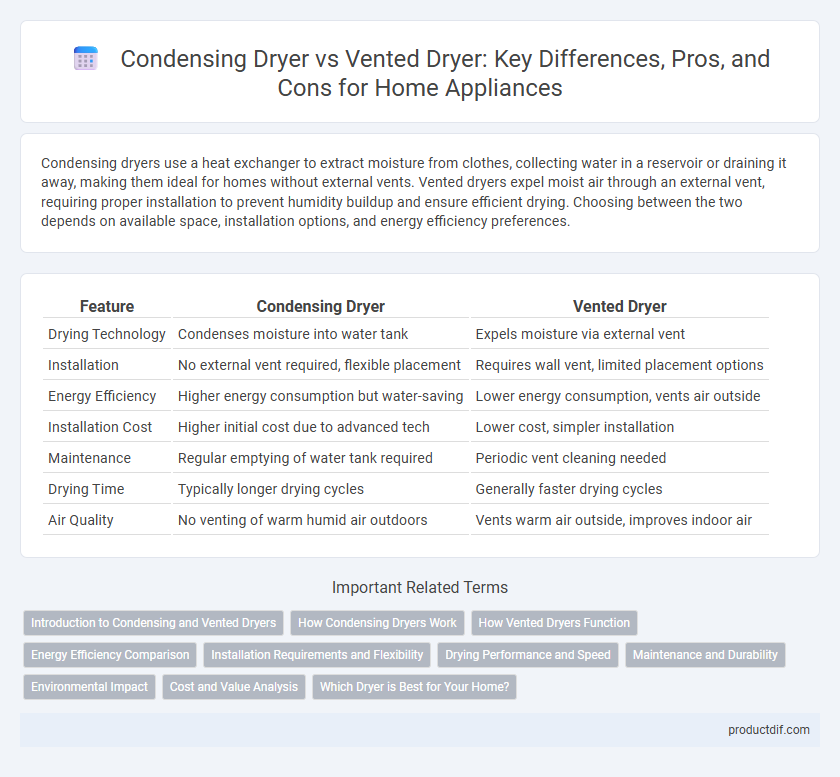Condensing dryers use a heat exchanger to extract moisture from clothes, collecting water in a reservoir or draining it away, making them ideal for homes without external vents. Vented dryers expel moist air through an external vent, requiring proper installation to prevent humidity buildup and ensure efficient drying. Choosing between the two depends on available space, installation options, and energy efficiency preferences.
Table of Comparison
| Feature | Condensing Dryer | Vented Dryer |
|---|---|---|
| Drying Technology | Condenses moisture into water tank | Expels moisture via external vent |
| Installation | No external vent required, flexible placement | Requires wall vent, limited placement options |
| Energy Efficiency | Higher energy consumption but water-saving | Lower energy consumption, vents air outside |
| Installation Cost | Higher initial cost due to advanced tech | Lower cost, simpler installation |
| Maintenance | Regular emptying of water tank required | Periodic vent cleaning needed |
| Drying Time | Typically longer drying cycles | Generally faster drying cycles |
| Air Quality | No venting of warm humid air outdoors | Vents warm air outside, improves indoor air |
Introduction to Condensing and Vented Dryers
Condensing dryers use a heat exchanger to remove moisture from clothes and collect it in a reservoir, requiring no external venting. Vented dryers expel warm, moist air through a duct to the outside, requiring proper installation for effective airflow. Choosing between them influences installation flexibility, energy efficiency, and moisture management in laundry areas.
How Condensing Dryers Work
Condensing dryers use a heat exchanger to remove moisture from clothes by condensing water vapor into liquid, which is collected in a tank or drained away. Unlike vented dryers, they do not require external ventilation, making them ideal for apartments or spaces without ducting options. This energy-efficient process recycles heated air, reducing heat loss and improving drying performance.
How Vented Dryers Function
Vented dryers function by drawing in air from the room, heating it, and passing it through the tumbling clothes to absorb moisture. This moist air is then expelled outside through a vent system, preventing humidity buildup inside the home. The efficiency of vented dryers depends on proper installation and regular maintenance of the exhaust vent to ensure optimal airflow and drying performance.
Energy Efficiency Comparison
Condensing dryers generally offer higher energy efficiency compared to vented dryers by recycling hot air and removing moisture through condensation, which reduces heat loss. Energy Star-rated condensing dryers consume up to 30% less energy due to advanced heat pump technology. Vented dryers expel moist air outside, requiring more continuous energy to maintain drying temperatures, leading to increased electricity usage.
Installation Requirements and Flexibility
Condensing dryers require no external vent, allowing installation in closets or rooms without outside access, while vented dryers must be positioned near an external vent for proper airflow and moisture expulsion. The flexible placement of condensing dryers makes them ideal for apartments or homes lacking suitable venting options. Vented dryers, though less flexible due to venting constraints, often have shorter drying cycles, balancing installation limitations with performance.
Drying Performance and Speed
Condensing dryers use a heat exchange system to remove moisture from clothes, resulting in efficient drying performance and faster cycle times compared to vented dryers. Vented dryers expel humid air outside, which can lead to longer drying durations and energy loss due to heat dissipation. Modern condensing dryers often feature advanced sensors that optimize drying speed while maintaining fabric care.
Maintenance and Durability
Condensing dryers require less frequent vent cleaning since they do not rely on external air ducts, reducing the risk of blockages and improving long-term reliability. Vented dryers demand regular maintenance of the vent hose to prevent lint buildup, which can lead to fire hazards and reduced efficiency. Condensing dryers generally offer greater durability by minimizing exposure to external elements that can cause wear and tear in vented systems.
Environmental Impact
Condensing dryers consume less energy than vented dryers by recycling hot air internally, reducing greenhouse gas emissions linked to electricity use. Vented dryers expel warm, moist air outside, leading to increased energy consumption as fresh air is continually heated. Choosing a condensing dryer supports eco-friendly household practices through higher energy efficiency and lower carbon footprints.
Cost and Value Analysis
Condensing dryers generally have higher upfront costs compared to vented dryers but offer significant savings on installation due to the lack of external vent requirements. Over time, condensing dryers provide better value by recycling moisture and reducing energy consumption, which lowers utility bills. Vented dryers have lower initial prices but may incur additional expenses for vent installation and increased energy use, impacting long-term cost efficiency.
Which Dryer is Best for Your Home?
Choosing between a condensing dryer and a vented dryer depends on your home's ventilation options and space constraints. Condensing dryers recycle hot air and do not require external venting, making them ideal for apartments or homes without external walls, while vented dryers expel moist air outside, offering faster drying times but needing proper vent installation. Energy efficiency, installation flexibility, and drying speed are key factors to consider when selecting the best dryer for your home.
Condensing Dryer vs Vented Dryer Infographic

 productdif.com
productdif.com